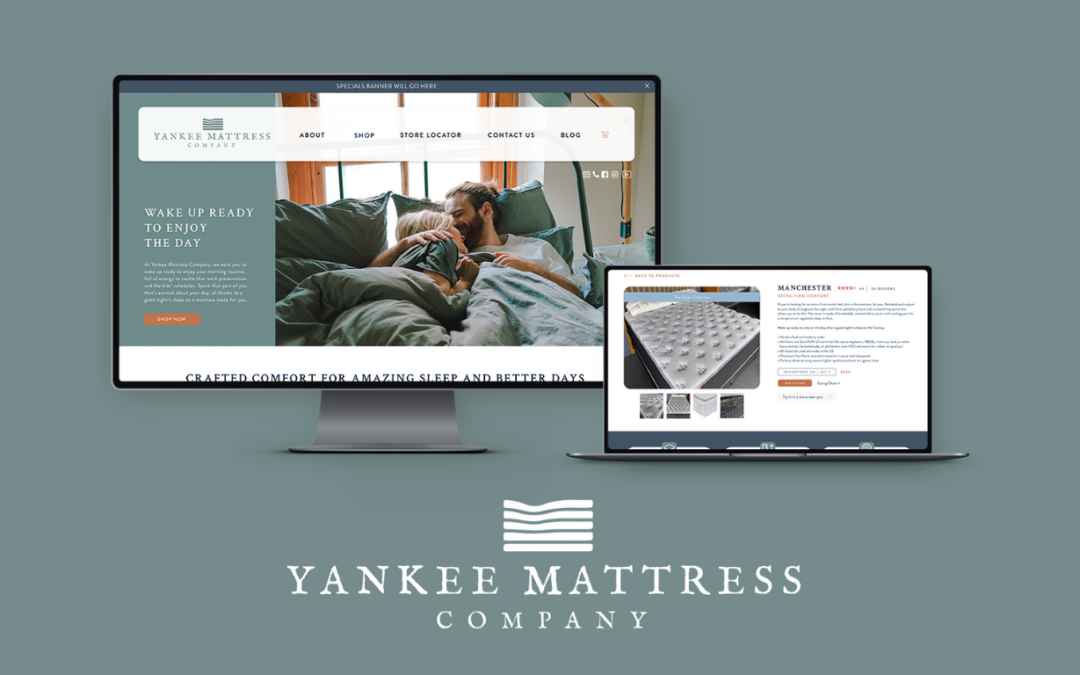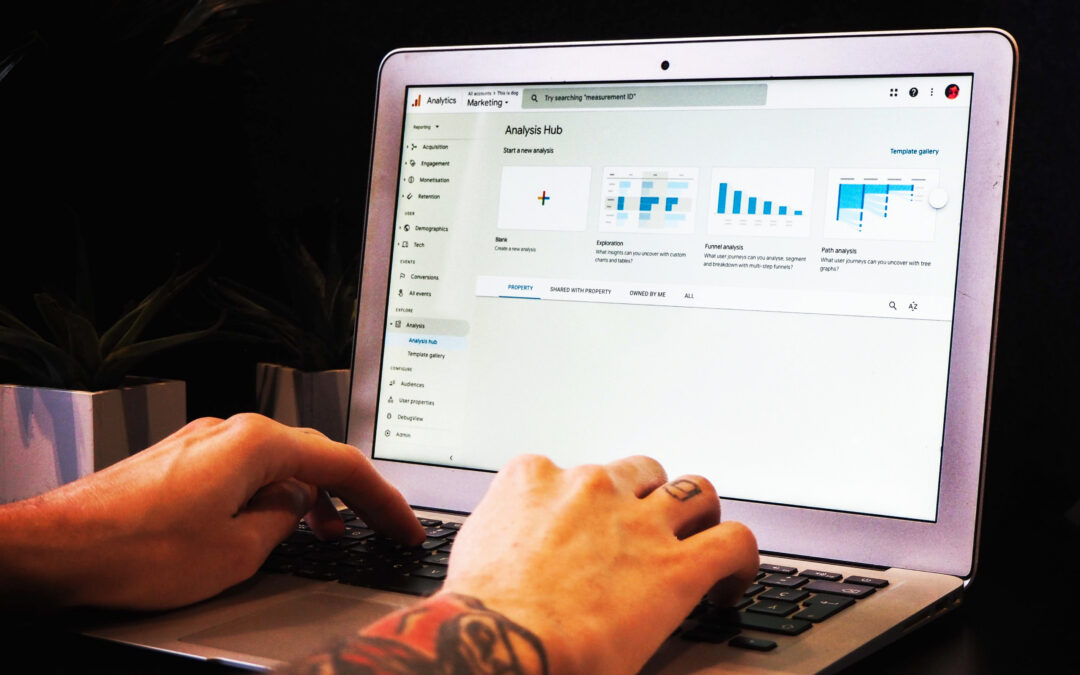
by threshold | Jun 6, 2024 | Creative, Design, Digital Marketing, General, Marketing
Yankee Mattress Company was looking for a revamp to its branding along with a new e-commerce website. They needed a more focused approach to their target market, with stronger messaging and values that elevated their branding to the same level as their high-quality mattresses.
Threshold wanted to position Yankee Mattress as more than a retail store, but an employee-owned company that’s invested in their customer’s quality of life.
our approach.
new brand positioning & naming.
Following extensive market and customer research, Threshold created two brand concepts for the client to choose from, both with a core purpose, messaging, tagline, brand voice, and visuals. Each concept brought the brand to a more modern place, differentiating it from competitors by highlighting the craftsmanship that goes into their mattresses.
a new brand look & feel.
The brand’s new messaging needed a new logo, brand guidelines, stationary, photography, apparel design, and more. We chose to design this brand with a logo font that spoke to handmade craftsmanship and a subtle mattress icon that would become a recognizable brand statement.
a killer e-commerce website.
Yankee Mattress’ previous website didn’t allow for a streamlined online ordering experience. Our website design included easily navigable shopping categories as well as detailed shop pages. Each mattress product page included custom graphic designs that detailed each section of the mattress materials, making it easy for customers to browse and select the mattress best suited for them.
We designed this website to mimic the in-store experience customers have, providing them with clear information so they could make informed decisions.
we love results.
The final brand not only connects better with the target audience, but it feels timeless and elevated. Each aspect of the brand ties in seamlessly with the next, inspiring the company’s employee-owners and ensuring the quality of the mattresses is felt within the quality of the branding.
One Year Post Website Launch (April 2023-March 2024):
- 446 New Users
- 7% Increase in Engagement Rate
- A 7% Reduction in Bounce Rate
before you go.
Yankee Mattress Company can now confidently say they’re crafting comfort for amazing sleep and better days. See the case study for a full look at the transformation our THeam created for them – and what we can do for you, next.
Let’s propel you forward too! Your place for your every marketing need, with us you can go a la carte or take all the carts. Talk to a Marketing Specialist today.

by threshold | Sep 14, 2023 | Digital Marketing, General, Marketing, Tech/Web, Thought Leadership
 Michael Pratt
Michael Pratt
How do you stand out in a sea of competition? By guiding your audience through a killer experience.
Effective UI/UX design is increasingly recognized as a cornerstone of successful digital marketing endeavors. And within the real estate industry, where visual appeal and user engagement are paramount, crafting immersive digital experiences is crucial.
We’re sharing the secret sauce to engaging your audience below, so don’t click away just yet!
first impressions. they’re kind of a big deal.
UI, the visual layout and aesthetics, and UX, the overall user experience, profoundly impact initial impressions.
In real estate marketing, where potential residents will turn away if properties aren’t presented in the best light, a well-designed and intuitive website fosters trust and encourages visitors to go down a rabbit hole of site exploring.
make every visitor a navigator pro.
In real estate marketing, streamlined navigation is, well, kind of essential. Intuitive UI/UX design ensures potential buyers can effortlessly browse listings, view property details, and access contact information.
A seamless navigation experience enhances user satisfaction and encourages conversion. Cha-ching!
tap into those emotions.
Effective UI/UX evokes emotional connections. High-quality imagery, immersive virtual tours, and engaging property descriptions amplify the emotional resonance of a property. What does this do? Lots.
Emotional engagement strengthens branding and increases the likelihood of prospective buyers reaching out.
not local? not a problem.
Navigating a real estate website should mirror the ease of visiting a property in person. Effective UI/UX ensures intuitive property categorization, filtering, and detailed property information presentation.
So even if your prospects aren’t local to the property location, this seamless exploration process enhances their satisfaction and encourages extended engagement.
get people inquiring about you.
UI/UX design influences users’ interaction with contact forms, chatbots, and other communication channels. Streamlined interfaces facilitate inquiries and foster trust, ultimately translating into increased lead generation.
to wrap it all up.
The potency of UI/UX design in real estate marketing cannot be underestimated. As online interactions increasingly shape buyers’ decisions, a strategic focus on immersive, user-centric experiences is paramount.
Don’t be discouraged! Threshold is an expert in this domain, employing innovative UI/UX strategies that truly transform real estate marketing.
By cultivating emotional engagement, streamlining interactions, and delivering personalized experiences, we underscore the potential of UI/UX to redefine success in the dynamic landscape of real estate marketing.

by threshold | Nov 9, 2021 | Digital Marketing, Marketing, Tech/Web
If you have a real estate website, when is the last time you dove into your Google Analytics? While most real estate marketers have a Google Analytics account set up for their website(s), many of them still underutilize this tool.
Not only is Google Analytics (GA) a must when it comes to integrating your Google Ad campaigns with site data like traffic volume and on-page conversions, it’s also one of the best tools at your disposal for understanding your online audience. Whether your goal is to reach more qualified users, improve conversion rates, or just gain a deeper understanding of who your audience really is, Google Analytics can help. You just have to know how to use it.
Today, we’re covering some of the best features of GA and showing how they can help you understand your audience better so you can execute more effective real estate marketing.

How To Find Out What Content Interests Your Audience The Most
Finding out what areas of your site draw the most attention from your audience can teach you a lot about what motivates them to take the next step and eventually become a tenant or customer. You can then use this information to make it easier to reach those sections of your site or even link users directly to this information by creating Search, Social, and Display Ad campaigns with messaging related to this information. For example, if users are engaging most with your floor plans page, you may choose to run ads highlighting your floor plan availability, or you may even choose to run a special on specific floor plans that are getting attention.
There are two key ways to gather this information: Screen Performance reports and Event Performance reports.
This report can be found in the Behavior section under Site Content. This will tell you the top pages on your site so that you can see which areas draw the most users. Bear in mind that this can be influenced by how easy it is to reach that section of your site, so take this information with a grain of salt. Think about how many clicks or turns of the scroll wheel it takes to view an area of your site and compare this to how many users actually view that area. If you have easy-to-access sections that no one is viewing or difficult-to-access sections that many users are seeking out, that can help give you ideas for site improvements or marketing campaigns.
This tool can also show you the time spent on each of these pages and the bounce and exit rates for each page, which offers further insights into which pages are your most successful drivers of prospect engagement.
Your Event performance can be found in the Behavior section under Events. This shows you what events people take most often on your site.
This information can help you diagnose whether people are taking the actions you want them to take on your site. For example, if you want people to use the contact page to get in touch with your leasing staff, you can check how often this event actually occurs on your site. If it’s not occurring very often, this could indicate that your contact form is difficult to find or use. It may even help you catch problems with your form, like a broken link or other UX issues.
Similarly, GA can show you your top conversions along with an Event count for those conversions. This can be found in the Conversions section in the left panel. Note that in order to get accurate conversion information, you first need to tell Google Analytics which events count as conversions.
How To Use GA To Tap Into Your Audience’s Interests
Did you know that the user demographics information in your Google Analytics account can show your users’ interests as well as their city, gender, age, and language? Not only that, but you can see which user interests correlate with the highest site engagement and conversions. This is located under “Audience” in the left pane, in the Interests section.

This information can help you create more accurate audience personas and inspire more effective marketing tactics. For example, if you find that many of your users are interested in the automotive industry, you might be inspired to draw more attention to your attached garages, covered carports, or EV charging stations through ads with targeted messaging or an amenity highlight on your home page, Google My Business page, or social accounts.
How To Find Out Who is Most Likely to Convert
At the end of the day, you want visitors to your website to take further action like scheduling a tour or starting an application. Luckily, Google Analytics has tools to help you understand who is converting, where they’re converting, and how often.
Engagement Reports
Engagement reports show you what actions users take once they’ve reached your site. An engagement report can be found by selecting “Audience” then “Behavior” and then “Engagement” in the left panel. These reports help you determine how well your site gets people to engage (by comparing total site users to users who actually engage). It can also show you which users are most likely to convert across factors like how they navigated to your site (e.g. organic search, link from social, search ad click, etc.) and user demographics.
Retention Reports
Similar to engagement reports, retention reports can tell you which users are interested enough to become a return visitor. A retention report will show you the number of return visitors you have over time, but it will also show you your number of return visitors by cohort. A cohort is a group of users who share a common characteristic such as when they first viewed your website. This feature is useful when you are making website updates, because it helps you determine whether those changes result in more return users, fewer return users, or no change. If a site update results in more return users, that’s a great sign that it’s generating more interest, more brand awareness, and ultimately more brand loyalty.
If you’ve configured your conversion events, you can easily compare users who convert to users who don’t convert. Navigate to Audiences in your left pane, then create an audience that includes a particular conversion event and another audience that excludes that conversion event. Once you’ve created these audiences, you can compare them in your reports. This will help you compare the behavior and attributes of converters vs. non-converters directly.
This can tell you the user behaviors and attributes that are most likely to lead to a conversion. For example, it might reveal to you that users who navigate to your floor plans page first are likely to convert, while users who visit your amenities page tend not to convert. This can help you diagnose site issues and show you where you should direct users through ad landing pages, home page links, or social media posts.
How To Understand Your Audience’s Full Renter Journey
Acquisition reports and user journey information in Google Analytics can teach you a lot about how users find and navigate your site and what behaviors make them most likely to eventually become a tenant. These features are particularly useful for understanding how your audience thinks as they navigate your site and can also give you insights into how to make your site experience more conducive to conversions.

Acquisition Reports
Acquisition reports are a small glimpse into your prospects’ renter journey before they have arrived to your site. It tells you where the user was before they came to your site and/or what action resulted in them arriving on your site. In other words, clicking on the Acquisitions section in the left panel will bring up reports showing you the sources bringing in new users; that might be organic searches, ad clicks, referrals from your social media accounts, or other behaviors like typing your URL directly into their address bar.
Knowing how users tend to get to your site is useful because it shows you where your energies are best spent when it comes to digital and print marketing strategies. For example, if people are coming in from organic searches, that could mean SEO enhancements are your best low-hanging fruit to gain even more users. But, if people are clicking over directly from your social media accounts, that means putting extra effort into your social media presence could deliver the highest ROI when it comes to generating site traffic.
Not only that, but these reports can show you whether a particular acquisition source correlates with higher rates of engagement and conversion. This information provides additional insight into how your different marketing tactics are resonating with users and whether a particular marketing tactic is aligning with what users eventually find on your site. For example, if users arriving from ad clicks tend not to engage with your site very much, you might want to ask yourself whether your ad messaging and design is consistent with what a user sees when they first land on your site.
User Path Exploration
One of our favorite features of GA is the ability to explore a user’s full journey through your website. The path exploration or Behavior Flow feature allows you to see how users tend to move from one screen, page, or event to another.
For example, it could tell you that users tend to start at your home page, scroll to a CTA button about amenities, click that button, arrive on the amenities page, then bounce. Or, it might show you that a common user journey is arriving on your floor plans page, clicking on a particular floor plan, viewing a virtual tour video, then navigating to your contact page and filling out a contact form. Each step of the way, you can see how many users make it to the next step, how many end up somewhere else, and how many exit your site altogether. You can even dive down into a specific user’s journey to help troubleshoot a specific user flow or create an audience segment based on that specific user flow to help you gain further insights into your audience.

All this information about how users move through your site can be an eye-opening experience for real estate marketers, designers, and web developers. For one thing, it can help diagnose problem pages that lead to the most exits and give you the opportunity to redevelop those pages. Or it can help you identify which landing pages lead most consistently to a conversion action further down the line, giving you the opportunity to direct more of your ads, social media links, or links in email campaigns to that page. Whatever you discover, diving into path exploration really helps you get in the mind of your users and see what’s important to them, what they find most eye-catching, and what messaging leads them to keep exploring and/or take action.

by threshold | Aug 11, 2021 | Creative, Design, General, Marketing, Thought Leadership
 Written by Emily Barker, Graphic Designer
Written by Emily Barker, Graphic Designer
In the midst of the murder of George Floyd and the ensuing protests around the U.S., the design community revived discussions of anti-racism and activism and how it fits into the field of Graphic Design. Just what exactly does designing for social change look like? Specifically in the field of marketing and advertising, the topic of social justice can often feel at odds with the day-to-day worklife in an agency. That’s especially true in the field of real estate–centered design, where the emphasis is often ‘heads-in-beds’ and being 100% leased up, without much room for discussions on equity. However, this sort of all-or-nothing thinking, especially in fields that are complicated, nuanced, and related to issues of housing and equity, can stymie conversations on race and equity before they even get started. The truth is that there are many avenues toward anti-racist marketing while also meeting the needs of clients whose focus is on leads and leases, and real estate designers have a unique position in advocating for those anti-racist strategies.
Creating Historically-Informed Real Estate Design
Anoushka Khandwala in her article entitled “What Does it Mean To Decolonize Design” talks about understanding the schema of one’s own history as a way to re-examine motivations and find new and better modalities of design for the future. She argues that, “With every design choice we make, there’s the potential to not just exclude but to oppress; every design subtly persuades its audience one way or another and every design vocabulary has history and context.”
What can that mean for us as real estate designers? At Threshold we delved into the history of redlining and the Fair Housing Act as a way to better understand the industry and its numerous failures and shortcomings. This meant a combined team of creative and digital staff researched the history of the Fair Housing Act and redlining to create an agency-wide presentation of the history of the Fair Housing Act and red-lining. The creative team made social posts outlining the history of redlining and the creation of the Fair Housing Act during the 1960’s Civil Rights Movement. For more information on redlining and how it denied Black American’s housing and generational wealth in the U.S. please click here.

What this revealed to us was that, as real estate marketers, we had an obligation to help our clients adhere to the FHA rules and regulations. Strictly speaking this meant using photos of diverse individuals in the marketing materials, ensuring that websites were ADA compliant, and using FHA and ADA icons. But it also revealed holes in the system or gray areas where we could advocate for our clients to choose inclusive marketing and branding strategies and also choose to go above and beyond in their digital marketing strategies to prioritize inclusivity.
How Designers Can Be Advocates for Social Change
In Jarrett Fuller’s article on Isometric Studios he describes the studio as one that is “rethinking the way in which designers build a better world”. The founders Andy Chen and Waqas Jawaid describe their clientele as broad: “We’ll take on any kind of client who demonstrates a desire to think about what authentic inclusion looks like, what foregrounding marginalized narratives looks like.” The article goes on to describe the work of Isometric as that of advocates as well as designers.
This is a familiar role for designers as we are already advocating for good design as we talk to our clients about our work and advise them on the best choices for their brand. Isometric Studios would take that same advocacy a step further and challenge the client’s perspective on social issues when needed and advocate for development of brands that support the greater social good. Sometimes this advocacy can look like recommending that a client incorporate people of diverse races in their lifestyle photography or choosing a logo that celebrates the existing community culture where their new development will be built.

One important way to have these conversations with clients is to directly addressing the elephant that is so often in the room: gentrification. By addressing this openly we are better able to advocate for our clients to help them maintain a positive reputation and resident satisfaction. These types of conversations present the opportunity for us to simultaneously advocate for our client and the greater community’s needs by encouraging our clients to create positive connections with their communities.
How do we ask our clients to connect with the communities they will exist in? Here are a few suggestions:
- Hosting events for the neighborhood at the property
- Striking mutually advantageous partnerships with local businesses
- Resident appreciation events that feature goods and services from the local community
- Hiring local instructors to teach fitness, art, or meditation classes
- Hiring local artists to design artwork for the property
- Host a concert of local musicians
- Offer communal spaces to local groups for weekly meetings
- Organize volunteer days with residents or staff in the local community
The point of these conversations and ongoing partnerships with the community isn’t to whitewash the real estate industry, but to offer real-world pathways for community engagement for our clients.
Isometric Studios, in their interview with Jarrett Fuller describes their name’s origin as “a floor plan drawn at a thirty degree angle where the same scale is used for every axis, creating a non-distorted image. ‘It’s an ideal that isn’t really possible,’ Jawaid said. ‘But we’re interested in that ideal. We’re designing for that ideal.'”
In the same way, we can also struggle towards a more ideal design practice in real estate design. We can become advocates for creative work that will be better suited for this current, complex, and multicultural world and our clients will benefit from the nuance that design will bring to their brands.









 Written by Emily Barker, Graphic Designer
Written by Emily Barker, Graphic Designer

